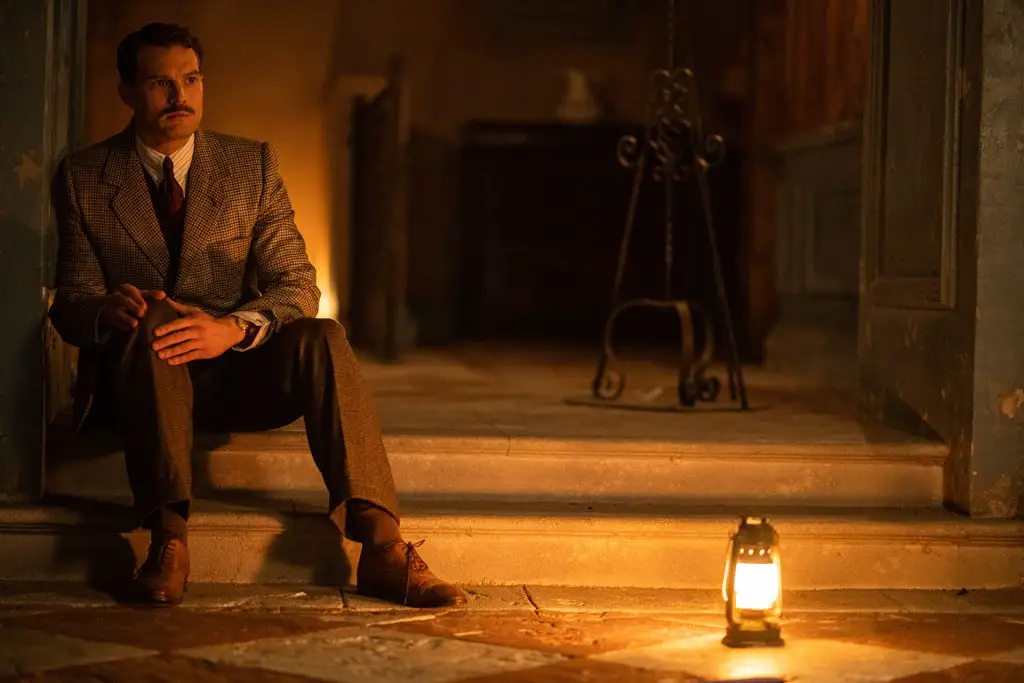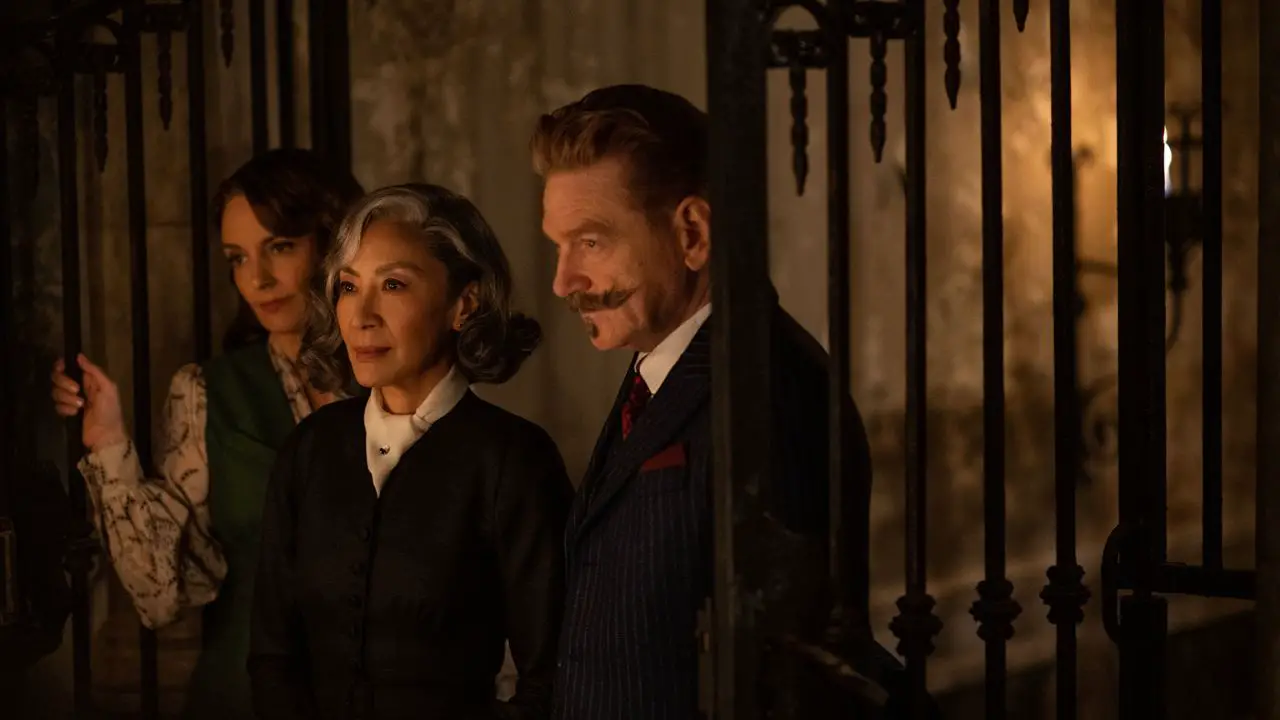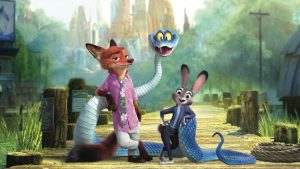Today, 20th Century Studios releases A Haunting in Venice, an unsettling supernatural thriller based upon Agatha Christie’s novel Hallowe’en Party. It’s the third film in the $490 million film franchise that began with Murder on the Orient Express (2017) and continued with Death on the Nile (2022). Kenneth Branagh returns as director, producer, and star of the latest installment, from a screenplay by Michael Green. Set in eerie, post-World War II Italy on All Hallows’ Eve, A Haunting in Venice finds the renowned (but now retired) sleuth Hercule Poirot (Branagh) living in self-imposed exile in the world’s most glamorous city. He reluctantly attends a séance at a decaying haunted palazzo—and when one of the guests is murdered, Poirot is thrust into a sinister world of shadows and secrets.
Like its predecessors, A Haunting in Venice boasts an all-star ensemble cast that includes Kyle Allen, Camille Cottin, Jamie Dornan, Tina Fey, Jude Hill, Ali Khan, Emma Laird, Kelly Reilly, Riccardo Scamarcio, and Michelle Yeoh. James Prichard, chairman and CEO of Agatha Christie Limited and Christie’s great-grandson, returns as an executive producer—and in an exclusive interview, he discusses taking the film franchise in a bold new direction.

Hallowe’en Party was first published in 1969. What makes Agatha Christie’s stories so timeless—and what makes the Hercule Poirot stories so perfect for film adaptations?
James Prichard: I think it’s the stories. That’s the simple thing, really. She had this extraordinary genius for inventing plots. Great stories stand the test of time and they also work across different cultures and languages, which is why we have such a global presence.
A Haunting in Venice deviates from Hallowe’en Party more so than the previous film adaptations of her work. How did you ensure it retained the right tone and same spirit?
James: One of the great things about this project is that the team has been together for quite a long time. Michael has written all three scripts, Ken’s directed and starred in all three, and Steve Asbell [President, 20th Century Studios] has been involved in all three. There’s an awful lot of trust involved in that. When they came up with the idea of doing Hallowe’en Party—but doing it very differently by setting it in Venice rather than an English country village, doing some fairly radical things with the story, and adding in a horror layer—we were working from a basis of trust. Michael has earned our respect, and when he said he wanted to do a few things with the story, we let him get on with it. Having done two quite faithful adaptations of very big, famous Agatha Christie titles with Murder on the Orient Express and Death on the Nile, we wanted to try to do something different and surprise our audience—both with a story that maybe they don’t know as well, and also with a tone that might surprise them. There are nods to the horror genre in this film, but it’s still a murder mystery. It may borrow from other genres, but I think it’s all the better for it.
With the added horror element, A Haunting in Venice takes the franchise in a new direction. Why was that right approach, as opposed going more comedic, for example?
James: One of the things I’m quite clear on is that I know my place; I know my skill set and I know where I can add value and where I can’t. I know quite well that I don’t have a creative bone in my body, so when you come into creative conversations, I trust the people who do have the creative bones—like Michael and Ken. And they both felt the horror genre was the way to go. There are lighter, funnier moments in the film; I think one of the things my great-grandmother is underestimated for is the way she used humor. But it was Michael and Ken’s idea to lean into the horror here. If we get to make more films, we might lean into other things, but I think Michael and Ken came up with a very good idea.
This marks your third film with Kenneth and Michael based classic literary characters. How has their understanding of Hercule Poirot and Agatha’s writing evolved over time?
James: Through these films, both Ken and Michael have investigated Poirot way more than my great-grandmother did in the books. Perhaps most obviously, he gets his backstory at the beginning of Death on the Nile—his First World War experience and the genesis of his mustache. This film has a slightly different story arc for Poirot. He starts off in a bit of a depression, shut off from the world in his Palazzo in Venice with his bodyguards protecting him from everyone. Ariadne Oliver [Fey] bullies her way in to see him and into investigating the case. Through the torment and torture of the case—which involves him coming to terms with the possibility that there is a supernatural being, that there is something beyond even his capabilities and understanding—he reaches a different level of contentment with the world and finds an ability to engage with it again. That’s a fun adjunct to the murder mystery, which is the traditional purveyor of an Agatha Christie story.

From Murder on the Orient Express to A Haunting in Venice, you’ve assembled a murderer’s row of talent. Why do so many actors want to be part of this film franchise?
James: I think there’s a renewed seriousness in her works, and I think actors are pulled that way. I think one of the big attractions is Ken. He’s obviously a very well respected director, but I think he’s also a director who actors like working for—or with. As an actor himself, he understands actors, and he’s sympathetic to actors. With all three films, if you speak to the casts, they’ve all had a lot of fun. Ken has a big theatrical background, and he treats these casts much more like a theatrical troupe than film actors. Inside and outside of work, they all seem to have fun, and they play games. Ken creates a sense of teamwork. That’s why people enjoy the experience of working on these movies, as well as the movies themselves.
Agatha Christie wrote more than 30 novels featuring Hercule Poirot. Have you given any thought as to which story you might want to adapt next with Kenneth and Michael?
James: I’m careful here, because I’d hate to get ahead of myself or tempt the fates. But I would be remiss to not say that if Ken and 20th Century Studios want to make more films, we will very happily come along for the ride. There are, obviously, other “exotics” you could do; you could do Evil Under the Sun or Appointment with Death, with their glorious settings. But I wonder if it wouldn’t be quite fun to do a more traditional English murder mystery after having done something really unexpected and surprising with A Haunting in Venice.






